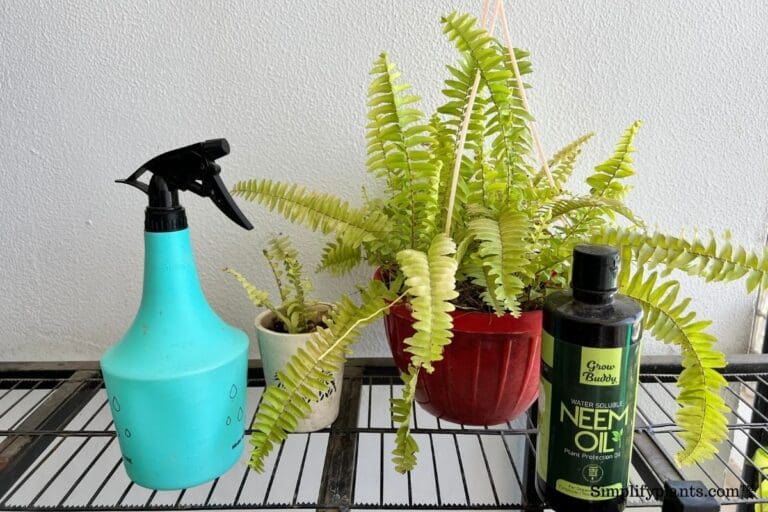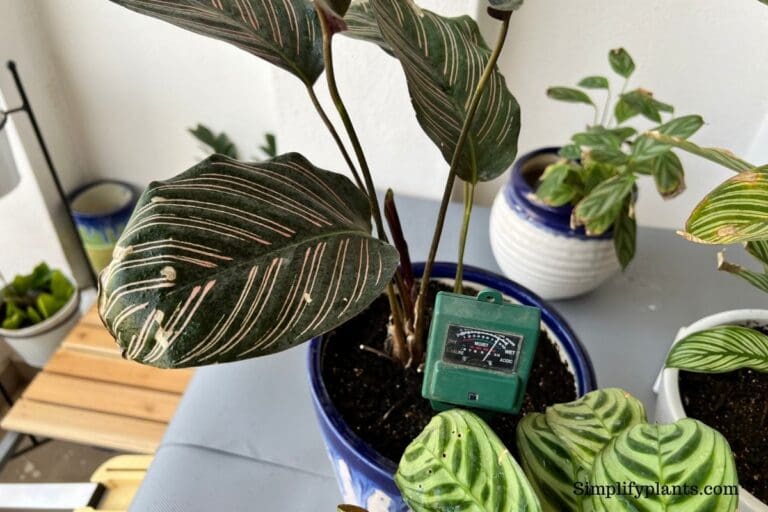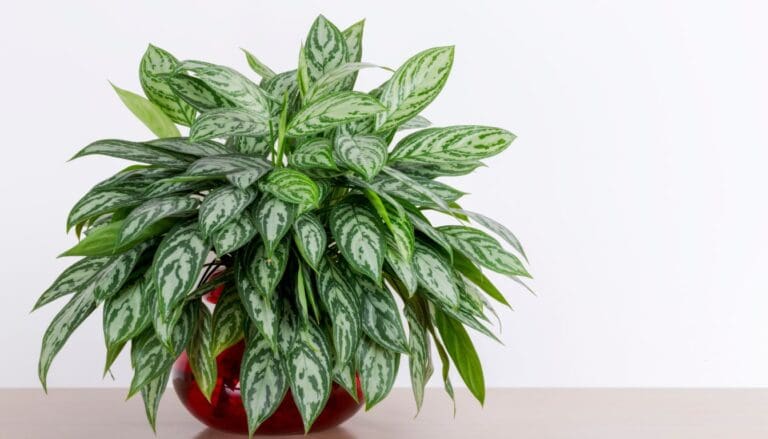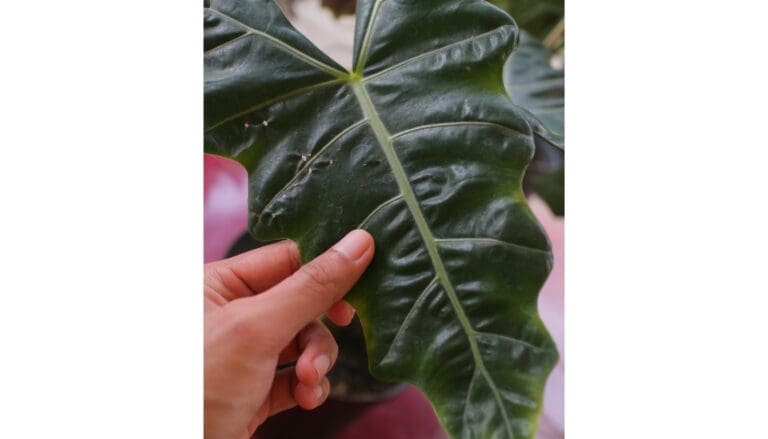How To Get Rid Of Bugs On Your Peace lily? (5 Common Bugs)
Peace lilies rarely attract bugs. But some bugs like mealybugs, scales, spider mites, and fungus gnats can infest your peace lily if they live in an unhealthy condition.
A healthy peace lily doesn’t attract bugs. However, if your peace lily is overwatered, overfertilized, or experiences high humidity, then bugs might infest them. Some common bugs that infest peace lilies are mealybugs, scales, spider mites, and fungus gnats. Use neem oil to get rid of them.
Pests or bugs are tough to get rid of. You should keep your peace Lily plant away from any other plant that has pest infestation as pests tend to spread from one plant to the other. Not removing the spent flowers can also lead to pest infestation.
Do not stress out if your peace lily has bugs. Let’s discuss how you can identify and get rid of these bugs.

Please note: Simplify Plants is reader-supported. Some links in the post are affiliate links and I get a commission from purchases made through links in the post.
Common bugs in peace lilies
Some common bugs that are found in peace lilies are:
- Mealybugs
- Scales
- Spider mites
- Fungus gnats
- Aphids
Let’s find out the different ways of identifying these bugs before we understand how to remove them from your peace lily.
Mealybugs
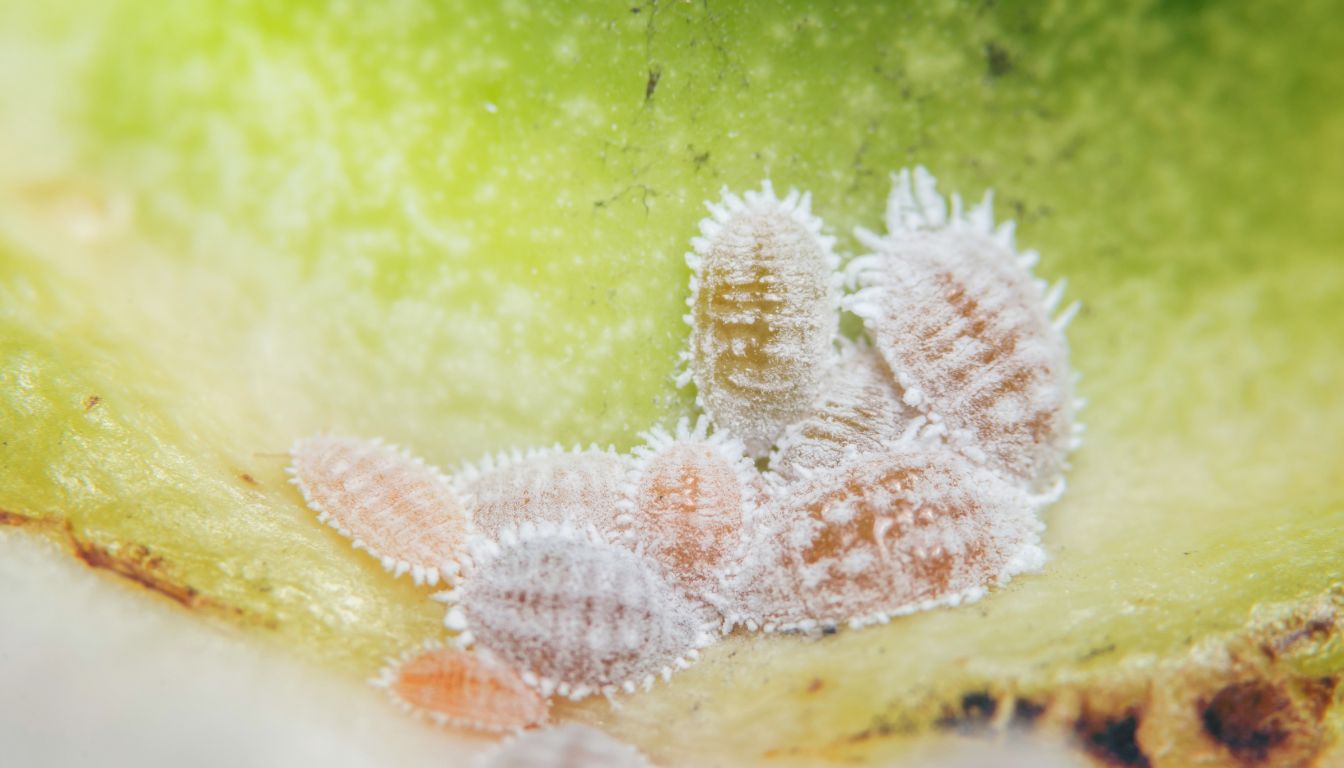
Mealybugs are fuzzy cotton-like bugs that are common in all houseplants. These pests suck the sap of the plants and secrete honeydew.
| Identification | Life cycle | Damage |
| -White bugs with waxy bodies. -Are under 0.2 inches. -Oval-shaped. -Brown and cream-colored bugs. -Male mealybugs have wings. -Found on the undersides of leaves. | -Lays eggs in a cotton-like pouch. -Hatch in a week after laying the eggs. -Become adults in 1-2 months. | -Stunted growth -Yellow leaves -Falling leaves -Deformed leaf growth |
Scales

Scales are tiny bugs that have a hardcover like a shell. You can notice small bumps on the leaves and stems of your peace lily if scales have attacked it.
| Identification | Life cycle | Damage |
| Armoured: -Hard covering over the bodies. -Do not secrete honeydew. -Leaves and feeds under the hard covering. Soft-bodied: -Soft, wax-like bodies. -Secretes honeydew. -Flat or spherical shaped. -Hard to get rid of as attaches itself to the foliage and stems. | -Eggs take three weeks to hatch. -The young bugs feed on the stems, foliage, and branches by piercing them. -The young bugs are soft-bodied initially but become armored as they develop. | -Yellow leaves -Wilting of leaves -Stunted growth -Yellow spots -Discoloration -Falling leaves -Reduced vigor |
Spider mites

Spider mites are tiny bugs that resemble spiders. These are hard to locate as they are hardly visible, but you can identify them with their damage to your plant.
| Identification | Life cycle | Damage |
| -Oval-shaped and extremely tiny. -Resemble spiders. -You will notice tiny reddish-brown specks. -Feeds on the tissues and sap of the plant. -Found on the undersides of leaves. -You can see web-like structures on the undersides of the leaves. -Secretes honeydew. | -Lay eggs in the winter that hatch in early springtime. -Reproduces and grows fast in warm and dry conditions. | -Tiny spots on the leaves -Curling of leaves -Discoloration -Falling leaves -Wilting of the plant |
Fungus gnats

Fungus gnats are identified as a cloudy substance over the plant. These can be a great botheration.
| Identification | Life cycle | Damage |
| -Larvae come with transparent bodies and black and shiny heads. -They feed on the roots and grow in damp soil. -Adults have long legs and wings. -Gets attracted to the plant that is overwatered. -Come in colors like grey or dark black. | -Can lay 300 eggs in moist soil. -Larvae come out of the eggs within 4 to 6 days. -Within 3-4 weeks, they become adults. | -Wilting of leaves -Yellow leaves -Poor growth -Damaged foliage -Loss of vigor |
Aphids

Aphids are dangerous bugs and can harm your peace lily to a great extent.
| Identification | Life cycle | Damage |
| -Soft-bodied and teardrop-shaped. -Come in different colors such as yellow, brown, green, black, and red. -Has antennae and cornicles. -They might or might not have wings. | -Lay eggs in spring that hatches in winter. -Grow and populate very fast and keeps populating and takes over your plant. | -Yellow leaves -Curled leaves -Wilting of leaves -Loses vigor -Stunted growth |
Problems that lead to pest infestation in peace lilies
Some common problems that can invite pests are:
- Overwatering
- High humidity
- Lack of airflow
Overwatering
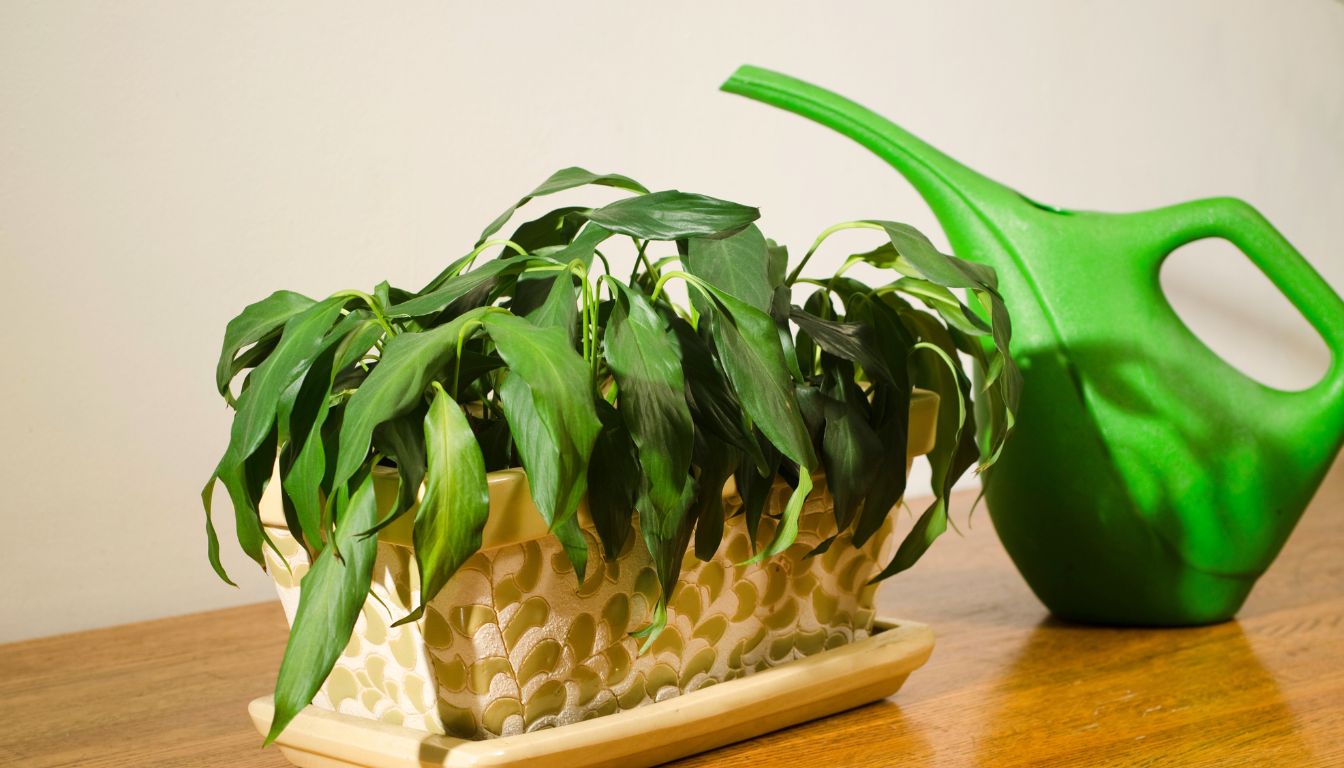
Watering is essential to keep your peace lily healthy, but too much watering will lead to an unhealthy plant. When you frequently water your peace lily, it gets overwatered.
An overwatered peace lily will invite pests as it bears the ideal environment for pest growth: soggy soil, poor drainage, and possible root rot.
Bugs thrive in a damp environment. So, an overwatered plant will bring pests other than all the other problems related to overwatering, such as root rot, fungal diseases, etc.
Therefore, you must let the soil dry out before you water your peace lily again. Watering the moist soil over and over will lead to overwatering.
High humidity

Most pests or bugs enjoy high humidity. Moist and damp places are ideal for their survival and growth.
If you provide too much humidity to your peace lily, the chances of pest infestation will increase. So, keep a check on the humidity and do not go overboard with it.
Along with high humidity, lack of aeration and overwatering will worsen the condition, making it better for the bugs.
Lack of airflow
Airflow is an essential factor for thriving plants. Proper airflow allows the plant to breathe and remain healthy.
If you place your peace lily in an area with good airflow, the soil will dry up fast, there will be less chance of fungal or bacterial growth, and the pests will not find it welcoming.
If you group your peace lily with other houseplants, it can hamper the airflow and increase the humidity, making it ideal for pesky pests.
How do I get rid of bugs on my peace lily?

Your peace lily must be treated as soon as possible if it has bug infestation but using the proper methods is vital to remove the pests altogether.
It might not be easy to kill every bug on your peace lily but keeping them under control is necessary. If you take proper care, the pests will not stay on your peace lily for long and will fly away.
You need to handle your peace lily with care as it might already be weak due to the pest infestation. Before going for the easy chemical techniques that might be harmful to the plant, consider the organic ways of getting rid of the pests.
We recommend the organic ways as you can rest assured that these will not harm your plant.
First of all, move your peace lily from its current location if other plants are around as you don’t want the bugs to reach them. Relocate in an isolated area and start the treatment.
Running water
The primary step to get rid of most pests is to wash your peace lily with a strong stream of water.
If there are visible pests on the plant, you can handpick them.
Wash your peace lily in the daytime so that the plant can dry out under the bright indirect sunlight.
Let the extra water run out of the drainage holes after you wash the plant.
Continue this every day to get rid of as many bugs as possible.
Horticulture oils
If you want to get rid of pests naturally, use horticulture oils. These oils suffocate the bugs and don’t allow them to breathe, leading to death.
Horticulture oils also disturb the metabolism of bugs.
You can spray horticulture oils on your peace lily after diluting it with water. Spray this after every few days to get rid of all the pests.
The good thing about horticulture oil is that it is not very toxic and evaporates fast. It treats the pests naturally and doesn’t harm the plant.
The best time to apply horticulture oil is during early summer or late fall. However, keep the following points in mind while using horticulture oil on your plant.
- Avoid applying if the temperatures are too high.
- Avoid spraying if the weather is too cold.
- Avoid spraying when the humidity levels are very high.
- Don’t apply if the plant has just been fertilized.
- Avoid using under the scorching sunlight.
Some common horticulture oils that are capable of removing bugs are soybean oil and cottonseed oil.
Neem oil

Neem oil (extracted from neem trees) can do wonders if used for removing pests.
Neem oil is mildly toxic to pests and affects the bugs’ metabolism, appetite, life cycle, reproduction, and breathing system. All these lead to death.
You can make a Neem Oil solution by adding 1-1/2 spoon of neem oil and 1 tsp dish soap to 1-liter water.
You can spray this all over your peace lily, especially on the underside of the leaves where the bugs reside.
Ensure to apply this when the plant is sitting in bright indirect sunlight and avoid applying if the temperature is too high.
Apply this once a week and continue till you get rid of all the pests. Don’t apply to stressed plants.
Rubbing alcohol
You can use rubbing alcohol if your peace lily has mild to medium bug infestation.
Rubbing alcohol removes the sticky pests very well, but it will not be effective if severe infestation. It would be better to go for other methods.
Add 1 part of alcohol to 3 parts of water, mix well, and apply them on the pests directly.
Insecticidal soap
A great way of eliminating bugs is by using insecticidal soaps. These are organic and biodegradable.
Insecticidal soap suffocates the pests and kills them without causing any harm to your peace lily.
Take a look at the steps of making the spray.
- Add 1 tbsp of liquid soap to 1-gallon water and shake it well.
- You can also add a cup of cooking oil to increase the effectiveness.
- Pour this mixture into a spray bottle.
- Spray this immediately on your peace lily.
- If your peace lily has a mild infestation, use this once a week.
- In medium or severe infestation, spray this every 2-3 days until the pests are in control.
Before using this on the whole plant, spray it on a small part for testing.
Limonene/Linalool
These are natural pesticides that destroy the wax coating of insects, damage their respiratory system, and ultimately kill them. These are safe for your peace lilies.
You can mix these with dish soap and spray them all over the plant and where the pests reside.
Ryania
Ryania comes in powder form and is extracted from ryania speciosa.
You can dust this all over your peace lily plant, and they will slowly kill all the pests on the plant.
Diatomaceous earth
Diatomaceous earth is a mineral-based insecticide. It is excellent for removing bugs.
They invade the protective layers of the pest’s bodies with sharp-edged dust. It can remove the pests without harming the plant.
Make the dust wet and apply it all over the infested plant.
Pyrethrin
This is a powerful natural composite that is derived from the dried leaves of daisies. It attacks the nervous system and paralyzes the pests, and kills them.
Pyrethrin is environmentally safe, and you can use this without any worry. Spray this once every few weeks based on the infestation.
If you notice the pests, you can spray this directly on them.
Rotenone
Rotenone is an insecticide that has no color or odor. This works well when the temperature is high and biodegrades fast in the soil,
Rotenone is highly toxic to bugs, and you can use this once a week on your peace lily.
While spraying it on your plant, maintain a distance of 15-20 inches from the plant.
How to prevent bugs on peace lilies?

Preventing the bugs is easier and a better option than removing them. Here are the tips to help you keep the bugs away from your peace lily plant.
- Maintain the correct temperature and humidity levels. Don’t let them go too low or too high.
- Do not place a newly bought plant with other plants of the house. Keep it isolated for some days and check to make sure it doesn’t have a pest infestation.
- Avoid overfertilizing or overwatering your peace lily, as these will make the plant sick and vulnerable to pests.
- You can spray a neem oil solution once a month to keep the pests away.
- Keep an eye out for bugs. If you notice any, handpick them.
- Clean the leaves of the peace lily with a damp cloth to prevent pests.
- Prune the spent flowers as those can attract bugs.
Ref: ScienceDirect, NCBI, University of Vermont, Nationalgeographic, NC state university, University of Florida, The University of Arkansas, Queensland Government.
Recommended Garden Supplies
| Product Image | Our Recommended Gardening Supplies | Check Offers! |
|---|---|---|
Top Top
Top
Top
Top
Top
Top
Top
Top | rePotme Houseplant and Tropical Classic Potting Soil Mix | Check Offer On Amazon |
 Top
Top
Top
Top
Top
Top
Top
Top | Espoma Organic Indoor Plant Food | Check Offer On Amazon |
 Top
Top
Top
Top
Top
Top
Top
Top | GooingTop LED Grow Light 6000K Full Spectrum Clip Plant Growing Lamp | Check Offer On Amazon |
 Top
Top
Top
Top
Top
Top
Top
Top | Soil Moisture Meter | Check Offer On Amazon |
 Top
Top
Top
Top
Top
Top
Top
Top | Govee Hygrometer Thermometer, Bluetooth Enabled! | Check Offer On Amazon |
 Top
Top | LEVOIT Humidifiers for Large Room(Best For Plants) | Check Offer On Amazon |
 Top
Top
Top
Top
Top
Top
Top
Top | Upgraded DIY Automatic Drip Irrigation Kit, 15 Potted Houseplants Support | Check Offer On Amazon |
 Top
Top
Top
Top
Top
Top
Top
Top | Stainless Steel Heavy Duty Gardening Tool Set | Check Offer On Amazon |
 Top
Top
Top
Top
Top
Top
Top
Top | Bonide Insecticidal Soap | Check Offer On Amazon |
 Top
Top
Top
Top
Top
Top
Top
Top | Bonide 32 oz Spray Neem Oil for Organic Gardening | Check Offer On Amazon |
 Top
Top
Top
Top
Top
Top
Top
Top | Garden Safe Fungicide | Check Offer On Amazon |



